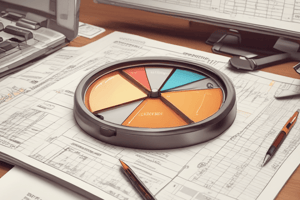Podcast
Questions and Answers
What is the primary purpose of dividing business activities into periods?
What is the primary purpose of dividing business activities into periods?
- To meet legal and tax obligations (correct)
- To improve employee productivity
- To enhance customer satisfaction
- To forecast future sales
Which component of the accounting cycle provides a detailed summary of individual accounts?
Which component of the accounting cycle provides a detailed summary of individual accounts?
- Closing Balance Sheet
- Journal
- Ledger (correct)
- Trial Balance
What is the economic exercise usually defined as?
What is the economic exercise usually defined as?
- A fiscal year from January 1 to December 31 (correct)
- A period determined by the corporate board
- A five-year period
- A three-month period
Which statement reflects the principle of business in operation?
Which statement reflects the principle of business in operation?
When are annual financial statements typically compiled?
When are annual financial statements typically compiled?
What does the Inventory of a company provide?
What does the Inventory of a company provide?
Which of the following is classified as a non-current asset on the balance sheet?
Which of the following is classified as a non-current asset on the balance sheet?
What is the Total Active amount listed for ANIOL, SA?
What is the Total Active amount listed for ANIOL, SA?
In the opening journal entry, which account is credited?
In the opening journal entry, which account is credited?
What differentiates the Balance Sheet from Inventory?
What differentiates the Balance Sheet from Inventory?
What is recorded in the Ledger?
What is recorded in the Ledger?
Which of the following is NOT a transaction type during the economic exercise?
Which of the following is NOT a transaction type during the economic exercise?
What is the purpose of a Journal Entry in accounting?
What is the purpose of a Journal Entry in accounting?
Flashcards
Accounting Cycle
Accounting Cycle
A series of activities in a business year to summarize financial information for users.
Periodicity
Periodicity
Dividing business activities into periods for legal, tax, and financial reporting needs.
Trial Balance
Trial Balance
A comparison of account balances to check for accuracy.
Initial Inventory & Balance Sheet
Initial Inventory & Balance Sheet
Signup and view all the flashcards
Economic Exercise
Economic Exercise
Signup and view all the flashcards
Balance Sheet
Balance Sheet
Signup and view all the flashcards
Journal
Journal
Signup and view all the flashcards
Ledger
Ledger
Signup and view all the flashcards
Journal Entry
Journal Entry
Signup and view all the flashcards
Debit
Debit
Signup and view all the flashcards
Credit
Credit
Signup and view all the flashcards
Assets
Assets
Signup and view all the flashcards
Study Notes
Introduction to the Accounting Cycle
- Businesses are assumed to operate indefinitely unless proven otherwise
- This continuous operation needs to be divided into time periods for various reasons
- Legal requirements (e.g., annual financial statements, tax reporting) necessitate this division
- Economic and financial insights are needed to guide effective management
- The most common time period is one year, often the calendar year (January 1st to December 31st)
- This one-year accounting period is called the "economic year"
- The accounting cycle comprises all activities conducted during an economic year to provide summarized information to stakeholders (usually annually)
- Key accounting activities form a process: initial inventory & balance sheet, journal entries, general ledger, trial balance, and final balance sheet
Accounting Principles
- The "going concern" principle assumes businesses will continue operations, not for liquidation purposes
- This principle is stated in the General Accounting Plan (GAP) and is crucial to the accounting process
Account Formulation
- Annual financial statements must be compiled every year within a 12-month period, except in cases of new business start-ups, change of fiscal year or company dissolution
Studying That Suits You
Use AI to generate personalized quizzes and flashcards to suit your learning preferences.
Related Documents
Description
This quiz covers the key concepts of the accounting cycle, including the division of business operations into time periods for financial reporting and management. It examines essential accounting activities such as journal entries and the preparation of financial statements. Test your understanding of the principles governing accounting practices.




